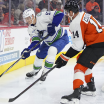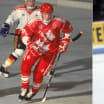The Coaches Room is a regular feature throughout the 2024-25 season by former NHL coaches and assistants who turn their critical gaze to the game and explain it through the lens of a teacher.
In this edition, Trent Yawney, a former assistant with the Los Angeles Kings, Edmonton Oilers and Anaheim Ducks, and head coach with the Chicago Blackhawks, writes from his personal experiences about how to handle a penalty kill that is struggling early in the season.
It was a week ago when I was talking to my son, Conor, who is in his first season as an assistant with the Prince Albert Raiders of the Western Hockey League. He runs the penalty kill there and they are struggling. In fact, they're last in the WHL at 66.7 percent.
Conor said to me about the PK, "Well, I think I should change it." I replied to him, "You've put all this time in and you're almost a quarter of the way through the season, and sometimes the more you change the further you would get away from something too."
We talked more about the topic and that's when we both realized it would be a good one for my first Coaches Room story.
The penalty kill is so important to a team's success. When I was in Los Angeles we would look at the percentage and ranking (I believe you have to be in at least the low 80s percent-wise to be a decent PK), but we would always ask ourselves and our players, "Is it helping us win games or causing us to lose games?"
If it was the latter, we would analyze why and go about trying to fix it.
When we got to training camp last season the penalty kill was an area that we knew we needed to improve. We played six games against the Edmonton Oilers in the 2023 Stanley Cup Playoffs and allowed nine power-play goals. Our PK caused us to lose games.
Last year, we did a great job and our penalty kill improved, but we got to the playoffs against Edmonton again and in five games allowed another nine power-play goals. So this year they changed the penalty kill, but now they look like they're caught in between and the PK is struggling through the early sample size of games.
So, my message to my son was you can't just look at the result, you have to look at if they're getting better, are they making headway with what you're trying to get them to do?
If you blow it up, you need to start from scratch again, but the season has started, and you need to get points. You don't have time to learn a new way of killing penalties. And if you blow it up, you're basically telling the players your plan didn't work and that gives them an excuse.
So how do you analyze it and break it down to fix what is wrong while keeping the principles of your PK intact?
Let's say you're getting seamed a lot with goals scoring off passes that are going through the teeth of the PK. Well, why are you getting seamed?
Where are your sticks? If the seams are big, why? Where is your positioning? Are you getting drawn out too far? Look at your structure and see if there is a pattern with the goals you are giving up on the PK.
The more times you ask why you usually come up with a solution.
Aggressive on the PK has become the catchphrase, but are you being collectively aggressive or just aggressive by running around? The Carolina Hurricanes are a good example, they're collectively aggressive and that's why you're going to need to make a good play to beat their PK.
A big part of penalty killing is blocking shots. Are you in the lane or are you pretending to be in the lane?
A lot of guys go down on one knee and goalies have told me it's hard to pick up the puck like that. I've told Conor this, tell your guys all your equipment is at the front of you, not at the side, so don't go to one knee and turn. You think you're in the lane, but you're not.
Goalies and goalie coaches want to know where the shots are coming from, so when you work on your penalty kill try to funnel shots in one way. Are you giving up shots from multiple locations on every PK?
If you're going to give up shots down the flank and that's what the goalie knows from the PK meetings then that's OK. But you can't be giving one up down the flank and the next one through a seam and then next one down and in.
I remember when I was in Anaheim, I asked John Gibson what he thought of our PK meetings. He told me they're good and don't change anything because "I know where the shots are coming from." That predictability is big on the PK.
There are other areas that require efficiency on the PK. For example, face-offs.
In the five playoff games we played against the Oilers last season we lost 67.6 percent of the face-offs. Edmonton was starting with the puck and then you're at their mercy. They could attack us right away.
If the PK isn't getting the job done, a tweak could be to change how you forecheck because that's the easiest thing to do to give it a different look. It might be enough of a wrinkle just going from a 1-3 forecheck to a box 2-2.
You might change up your pairs up front to show a different look.
What you don't want to change is how you defend in zone. When you're in zone you've got sort outs to run and there are different sets that teams use on the power play. Steering away from your principles could lead to a gray area where the players are coming back to the bench going, "What do I do there?"
You can't have gray on something as important as the PK.
Conor was lamenting to me that the penalty killers in Prince Albert are not clearing the puck when they have the time. Why not? What is happening when they get the puck on their stick in the defensive zone?
So, Conor spent some time with us in Los Angeles and he's ventured out into the coaching world, but he's run into the PK issue and he asked the question, "Should I blow it up?"
Nine times out of 10 the answer is no. Instead, ask yourself are you making headway? Does the video analysis and statistics show a pattern? Go through all of it, because the answers are there. Don't blow it up until you've exhausted everything possible.


















